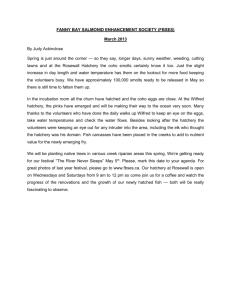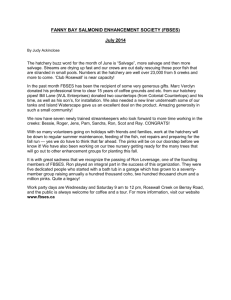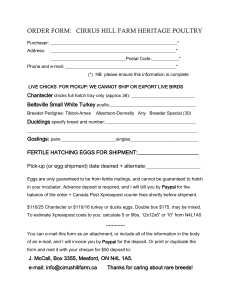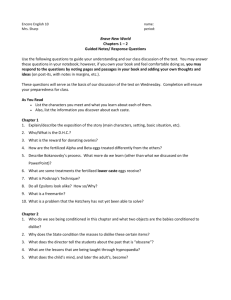Small Hatchery Management
advertisement
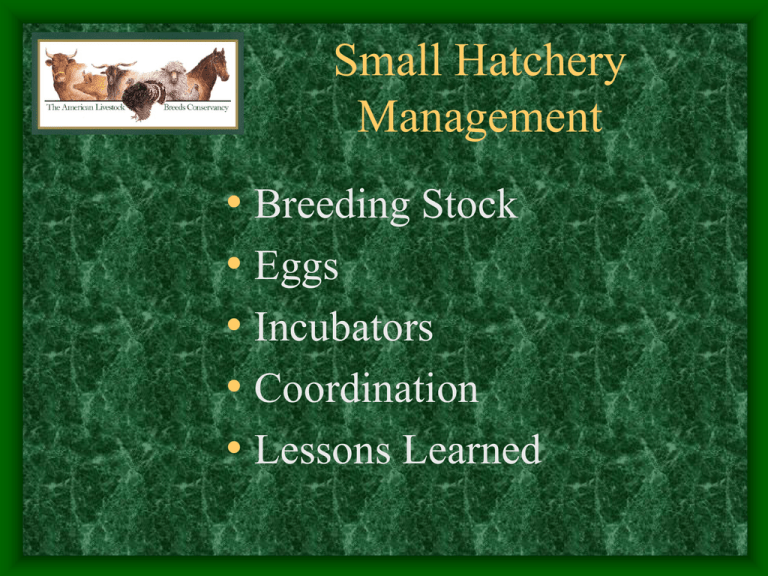
Small Hatchery Management • Breeding Stock • Eggs • Incubators • Coordination • Lessons Learned Small Hatchery Management - Breeding Stock - • Fertility • Egg Production • Feed Requirements Small Hatchery Management - Breeding Stock Fertility Considerations: • Breed Characteristics • Health – NPIP status and physical freedom from parasites and disease • Male to Female Ratio • Spurs and Feathers Small Hatchery Management - Breeding Stock Egg Production Considerations: • Male Fighting and Hen Harassment • Lights – 14 Hours • Parasite Management • Disease Management • Timing Production Small Hatchery Management - Breeding Stock Feed Considerations: • Breeder Feed • Fresh, Clean, Unfrozen Water • Oyster Shell • Wheat Germ Oil • Cod Liver Oil Small Hatchery Management - Eggs - • • • • Proper Storage Condition Shipping Candling Small Hatchery Management - Eggs Storage Considerations: • Location – out of sun and drafts, with constant temperature; a cooler is ideal • • • • Temperature/Humidity – ideal is 60 degrees F Air Cell Up Rotate – daily rotation will improve hatch Duration Effects on Hatchability/Viability – best results are obtained from eggs 7 days and less, 10 days or less provide good results, but viability drops sharply from day 10 Small Hatchery Management - Eggs Condition Considerations: • Odd Shapes – likely not viable; may indicate poor air cell position • Cracks – will allow entry of bacteria; can be sealed using candle wax • Dirt – infect incubator with bacteria; wet dirty eggs likely not to hatch due to infectious agents being drawn into the egg Small Hatchery Management - Eggs Shipping Considerations: • Effect on Viability – jarring can damage air cell and loosen embryo attachment • Proper Methods – wrap in newspaper or paper towel so that movement with egg carton is prevented; when mailing, allow several inches of cushioning material around cartons • Resting Overnight – allow eggs that have been transported/shipped to rest over night at room temperature, this will allow air cells to reform and result in better hatch Small Hatchery Management - Eggs Candling Considerations: • Candle at 7-10 Days • Again at Day 18 • Method • Meanings of Observations Small Hatchery Management - Incubators - • Location • Temperature/ Humidity • Incubation Cycle • Cleanliness Small Hatchery Management - Incubators Location Considerations: • Constant Temperature and Humidity • Away from Sun • Clean Environment Small Hatchery Management - Incubators Temperature and Humidity Considerations: • Constant 99.5 degrees F • Humidity 55% during First Two Weeks • 65% during Hatch/Last Two Weeks • Low Temperature can Delay Hatch • High Temperature can Accelerate Hatch • Low Humidity can cause Pipping with Inability to Hatch • High Humidity can cause failure to seal navels and drowning during hatch Small Hatchery Management - Incubators Incubation Cycle Considerations: • Run Incubator for 5 Days with Correct Temp/Humidity before Setting • 2 Weeks in Incubator • 1 Week in Hatcher Small Hatchery Management - Incubators Cleanliness Considerations: • Clean Incubator and Hatcher at Start of Season • Separate Hatcher allows Succession Settings without Debris Concerns • Use 1-2 Tablespoons of Pinesol per Gallon of Water for Humidity • Dry, Vacuum, and Spray between Hatches Small Hatchery Management - Coordination - • Hatch Planning • Chick Distribution • Cleaning Cycle vs. Incubation Cycle Small Hatchery Management - Coordination Hatch Planning Considerations: • It Takes 2 Weeks to Know Sire • Once Lay Commences, Save Eggs for 1-2 Weeks • It Takes 3 Weeks to Hatch • It can take 4-7 Weeks from Commencement for First Chicks to Hatch Small Hatchery Management - Coordination Chick Distribution Considerations: • Once Chicks Hatch They must be Placed • Power Outages and Other Temperature Fluctuations can Alter Hatch by 1-2 Days • Number of Chicks Hatched may be Greater of Fewer than Number Planned • Shipping Chicks Requires Additional Planning and Labor Small Hatchery Management - Coordination Cleaning Cycle vs. Incubation Cycle Considerations: • When Setting Once Every 2 Weeks, Plan to Clean Hatcher within 2 Days of Chick Removal • When Setting Once Per Week, Hatcher must be Cleaned on Day of Hatch Small Hatchery Management - Lessons Learned - • Pedigree • Hatch Cycle • Management Issues • Other People Small Hatchery Management - Lessons Learned Pedigree Considerations: • Pedigree is useful in Planning Matings • Pedigree Marking of Day-old Chicks is Done by Toe-punch • Chicks must be Separated According to Mating before They Hatch • Labor to Pedigree increases Time Spent to Take-off Hatch from 15 Minutes to 50 Minutes Small Hatchery Management - Lessons Learned Hatch Cycle Considerations: • Hatching Every 2 Weeks is better due to Reduced Workload and Increased Hatch Sizes • Setting Every Hatch on the Same Weekday makes Keeping Track of Hatch Due Dates Much Easier • Maintaining Hatch Intervals is Useful, Giving Regularity to Schedule Small Hatchery Management - Lessons Learned Management Considerations: • Broody Hens cause Fertile Eggs to begin Growth, Saving these Started Eggs Kills Embryo • Someone must Maintain Breeding Flock • Breeder Replacements must be Grown, Selected, and Maintained Small Hatchery Management - Lessons Learned Other People: • When Pooling Hatching Eggs: May have Schedule Conflicts • May have Different Expectations (breed performance, chick availability, expenses) • May Attempt to Reduce Feed Costs by Using Lower Quality Feed – thus Reducing Viability • Industry Controls Each Segment – feed, breeding stock, incubation, housing, processing – for Good Reason
